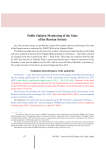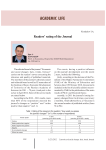Economic and Social Changes: Facts, Trends, Forecast @volnc-esc-en
Статьи журнала - Economic and Social Changes: Facts, Trends, Forecast
Все статьи: 1745
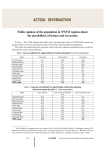
Public opinion of the population in NWFD regions about the possibilities of leisure and recreation
Статья обзорная
Бесплатно
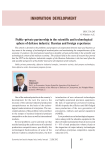
Статья научная
The article is devoted to the problems and prospects of cooperation between state and business as key areas in the strategy of technological modernization and maintaining the competitiveness of the economy. It analyzes the international experience of public-private partnership in the scientific and technological content of the military economy. The analysis held in the course of research has proved that the PPP in the defensive industrial complex of the Russian Federation is the best and often the only possible perspective of the further innovative development of the industry.
Бесплатно
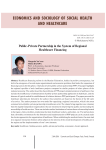
Public-private partnership in the system of regional healthcare financing
Статья научная
Healthcare financing reform in the Russian Federation, besides its positive consequences, has led to the emergence of several major organizational and economic problems that hinder the expansion of financing sources for this sphere, which also involves public-private partnership (PPP). The paper highlights the regional specifics of such healthcare projects compared to similar projects of other spheres of the national economy. The author describes the problems of PPP projects implementation in healthcare; they include the insufficiency of substantiation of public-private partnership application in healthcare, and the absence of typical models for establishment of relations between PPP participants. The paper presents the healthcare priorities put forward by the author; these priorities are based on the theory of the life cycle of a service. The author presents her own model for organizing a regional concession, which is the most common form of public-private partnership in healthcare so far...
Бесплатно
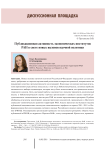
Publishing activity of RAS economic institutes amid new challenges of science policy
Статья научная
New challenges of science policy in Russia have determined a number of objectives which require scientific institutions to implement specific solutions aimed at improving research quality and efficiency. Since the evaluation of research results requires the use of different metrics, including bibliometrics, the main issue lies in the choice of indicators which can be used to conduct multi-analysis. The aim of this study is to implement the holistic approach to bibliometric assessment of scientific institutions and to analyze the performance of academic activity of economic institutions on the basis of the proposed criteria. The article summarizes the results of scientometric indicators monitoring, conducted at the Institute of Socio-Economic Development of Territories of the Russian Academy of Sciences. The analysis is based on a large set of publications of academic economic institutions for the period 2011-2015. The informational basis of the research includes data of the Russian Science Citation Index (RSCI)...
Бесплатно
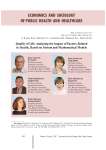
Статья научная
The paper considers the formation of the structure of the indicator of the quality of health as a major factor that has the greatest impact on the quality of life. The paper also analyzes the properties of the proposed structure and main approaches to assessing and measuring the quality of life and quality of health. It is established that the integral indicator of health quality has a complex structure that belongs to the class of hierarchical structures. The paper studies properties of hierarchical structures with the help of systematic approach, according to which the integral indicator of health quality was broken down and three components (system indicators) were identified. They are as follows: quality of care, quality of environment and quality of health. Each component, in turn, was broken down and presented as a triad of interrelated objective and subjective indicators of lower level (partial indicators). The proposed system model for assessing the integral indicator of health quality is a spatial structure of this indicator, which takes into account the links between system indicators at the median level and the links between partial indicators at the lower level...
Бесплатно
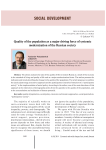
Quality of the population as a major driving force of systemic modernization of the Russian society
Статья научная
The article analyzes the state of the quality of life in modern Russia as a result of the increase in the standard of living and quality of life and as a major modernization factor. The author presents the indicators and trends describing the change in the quality of the population. The article proposes to combine the classical patronage (extensive) approach and the participatory (intensive) formation of a “participatory society” in the implementation of social policy. According to the author, one of the main directions of this approach is the redirection of demographic policy from the quantity to the quality of the population, and to the accumulation and realization of human potential.
Бесплатно
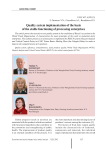
Quality system implementation of the basis of the stable functioning of processing enterprises
Статья научная
The article proves the necessity to use quality system in the conditions of Russia's accession to the World Trade Organization. It characterizes the main principles of this work in industrial dairy enterprises. The authors present a set of measures to implement the HACCP system (Hazard Analysis and Critical Control Points) at CJSC Totma Butter-Making Plant (the Vologda Oblast) in order to improve the competitiveness of its products.
Бесплатно
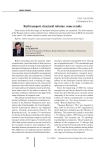
Rail transport structural reforms: some results
Статья научная
Some results of the third stage rail transport structural reforms are examined. The short analyses of the Russian railway system, infrastructure, rolling stock and main directions of R&D are presented in the article. The author touched economic and social impacts of reforms.
Бесплатно
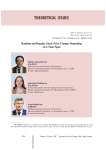
Random and regular stock price change depending on a time span
Статья научная
The purpose for the research is to identify the correlation between random (accidental) stock price changes and its well-known tendency to grow depending on a time span. In contrast to the works of other scholars on the issue of the random nature of stock prices the presentation of the issue is new in the current research. The research method consisted of identifying the criterion stock price change separation into random and regular components and further comparing the proportions between random and regular stock price change on the example of 10 stocks of the largest world-known companies from representing different economic sectors traded on New York stock exchange for several time spans: one day, week, month, quarter, half-year and one year. The main research results suggest that with the increase in time span the share of the regular origin of the stock price increases, but only up to a certain significant limit. The increase in the time period of analyzing the stock price changes (fluctuations) does not prove that the random character of stock price change has an unlimited downward trend...
Бесплатно
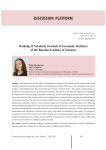
Ranking of scholarly journals of economic institutes of the Russian Academy of Sciences
Статья научная
The paper presents the results of comparative ranking of the journals in economics and related disciplines issued by economic institutes of the Russian Academy of Sciences. The ranking is based on the analysis of the bibliometric data of the Russian Science Citation Index. The author substantiated the composition of indicators that, in the author’s opinion, provide the most objective approach to evaluating the importance of the title in the scientific community, are the most transparent and make it easy to verify the results obtained. The ranking is based on an integral index calculated by the method of multidimensional comparative analysis. The index was calculated with the use of standardized coefficients, by normalizing the bibliometric indicators relative to the maximum values of the indicators under comparison. The data thus obtained helped distinguish the core consisting of ten leading journals in economics and related disciplines among those published by economic institutes of the Russian Academy of Sciences. These journals include publications with significant citation metrics and a wide range of contributors and readers. The degree of correlation between the final list and other rankings of economics journals proves that the composition of criteria proposed by the author and the method of aggregation makes it possible to obtain sufficiently accurate data suitable for ranking scientific journals.
Бесплатно
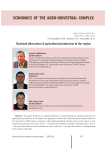
Rational allocation of agricultural production in the region
Статья научная
The paper proposes an original approach to determining the optimal allocation of agricultural production in the region; the approach includes the methodological substantiation of the necessity to differentiate consumers when addressing food security issues in the region. It was proposed to allocate three levels: level 1 - the provision of food to socially vulnerable layers, level 2 - the provision with food at the subsistence level, and level 3 - the provision of the total population of the region with food. A preliminary forecast was made for each municipality; it analyzed possible changes in the number of the socially vulnerable up to 2020; in accordance with medical standards and norms of the subsistence level the volumes of food were calculated, which in turn were compared with the actual production output. The difference between the actual volume and the volume of evidence- based requirements represented the very increase in the volume of production, the achievement of which requires certain investments on the basis of capital-output ratio...
Бесплатно
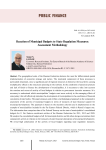
Reaction of municipal budgets to state regulation measures: assessment methodology
Статья научная
The geographical scale of the Russian Federation dictates the need for differentiated spatial implementation of economic strategy and tactics. The municipal component of these processes is particularly important, since a significant part of regional resources is formed at the local level, causing multiplicative effects in the structures operating in the territory. In the conditions of sanctions pressure and lack of funds to finance the development of municipalities, it is necessary to take into account the reaction and extent of activity of local budgets in relation to government incentive measures. It is necessary to understand which municipalities’ budgets react more actively to the managing effects of state policy; this will effectively stimulate the development of municipalities in the conditions of financial constraints of state bodies. The paper proposes and verifies a methodological approach to the comparative assessment of the activity of municipal budgets in terms of measures of state financial support for municipal development. The approach is based on the maximin criterion and is implemented on the example of municipalities included in the Far Eastern Federal District, which is Russia’s largest one. The information base comprises data of the Federal Treasury on the state of municipalities’ consolidated budgets for 11 Far Eastern constituent entities of the Russian Federation for 2011, 2015 and 2020. We analyze the consolidated budgets of all 164 municipal districts and 66 urban okrugs and estimate their comparative activity in relation to the measures of state financial stimulation of municipal development. We reveal high polarization of the activity of local budgets regarding state regulation measures. We show that the budgets of urban okrugs react more actively to government measures than the budgets of municipal districts. The budgets of urban districts formed a group of local budgets with the most active response to state regulation measures. Nevertheless, the transition of the Magadan and Sakhalin oblasts to single-level local government systems consisting only of urban okrugs by 2020 did not contribute to increasing the activity of the budgets of urban okrugs in these regions in relation to state regulation measures in comparison with other municipalities of the Far Eastern Federal District. The proposed mechanism makes it possible to provide territorial administration bodies with methodological tools for in-depth analysis and comparative assessment of the extent of activity of municipal budgets in relation to state regulation measures.
Бесплатно
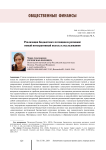
Realization of the regions’ budget capacity: a new integrative approach to the research
Статья научная
The paper investigates theoretical aspects related to the implementation of budget capacity at the stages of its formation and use. Having studied the determinants of socio-economic development contained in various economic doctrines, and taking into consideration the modern context of the functioning of the Russian economy, we show that the realization of budget capacity is an important factor in socio-economic development. The systematization of diverse views on the essence, definition of a set of controversial issues regarding the content and problems of implementing the regions’ budget capacity shows that the theoretical and methodological basis for its formation and use is limited. The paper considers the economic category “region’s budget capacity” from the perspective of integrating resource, fiscal and institutional characteristics, representing a set of not only created, but also attracted gratuitous / non-gratuitous budget resources, as web as reserves that can be realized under the influence of external / internal constraints and incentives. This interpretation makes it possible to specify the concept of “maximum achieved budget capacity of the region” as a capacity that has been implemented, and “the maximum achievable budget capacity of the region” as a set of implemented, reserve and hidden capacities. The article substantiates basic provisions of the integrative approach. The materials can be used in educational activities in studying disciplines in the field of finance, economics and management; they can also be useful to researchers as a basis for further research, and to management bodies of different levels to substantiate management decisions.
Бесплатно
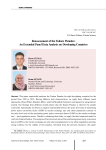
Reassessment of the Todaro paradox: an extended panel data analysis on developing countries
Статья научная
This paper empirically analyzes the Todaro Paradox for eight developing countries for the period from 1992 to 2019. Having different data characteristics, we apply three different panel approaches (Fixed Effect, Random Effect, and Full Modified Ordinary Least Square) by using distinct models. Our findings from different models depict that the Todaro Paradox is valid for the sample economies. Specifically, we observe a negative relationship between the price level ratio of purchasing power parity conversion factor (GDP) to market exchange rate and urban population contrary to the price level ratio of the purchasing power parity conversion factor (GDP) to the market exchange rate - rural population nexus. Thanks to obtaining these links, we apply the third empirical model to verify the Todaro Paradox. The analysis of the price level ratio of the purchasing power parity conversion factor (GDP) to the market exchange rate and total unemployment in the urban population provides strong evidence for the validity of this paradox. Deviated from the previous literature, this paper applies the price level ratio of the purchasing power parity conversion factor (GDP) to the market exchange rate since the higher the purchasing power parity of a country, the lower the rate of rural-urban migration is expected. By using one extra variable (unemployment), we test the Todaro Paradox. This combination of variables as well as different panel techniques (Fixed Effect, Random Effect, and Full Modified Ordinary Least Square) allow us to draw more robust conclusions. To address the challenges posed by rural-urban migration, policies should be designed to promote sustainable development in both urban and rural areas. This can include measures to create employment opportunities and improve the quality of life in both areas, as well as policies to regulate migration and manage the pressures caused by rapid urbanization.
Бесплатно
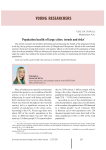
Recycling as the mechanism of ecological and economic equation of the regional development
Статья научная
In the article the role of recycling as the mechanism of the ecological and economic equation of the regional development is considered. The concept of recycling is proved; the problems, conditions and factors of its development are explored. The measures of recycling waste products from production and consumption are analyzed; recommendations on the recycling development in the region (including the organizational economic mechanism) are given.
Бесплатно

